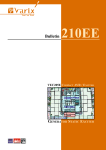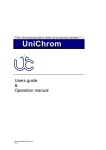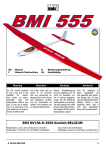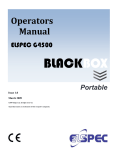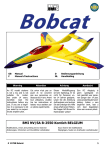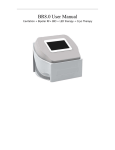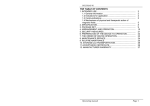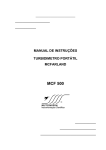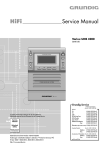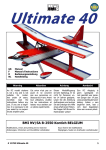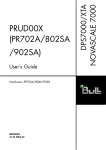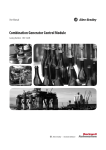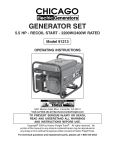Download VEC204D Static Exciters
Transcript
Bulletin 209EE VEC204D MULTIFUNCTION REGULATOR COMPACT STATIC EXCITER / DRIVER VEC204D Static Exciters BULLETIN 209EE VEC204D/1/F/50 The VEC 200 series is a product family that includes AVRs (Automatic Voltage Regulators) for Generators, Static Exciter and Drivers for Synchronous Motors and Alternators, High Current Controlled Rectifiers or Simple 1 quadrant DC Motor Drives. The VEC204D is a multifunction Regulator / Exciter / Driver well suited to Synchronous Motors applications. The VEC204D is an economical multifunction, monoboard architecture, plug in, reliable product with good performance. The VEC204D incorporate some functions and protections features. The type of control signal can be chosen when ordering. The VEC204D has separate P + I + D adjustments that together with its sensing characteristics enable it to fit in virtually any process. Five adjustments are available at the front panel. Eight LED indicates its functions and failure conditions. Eight DIP Switches at front panel, simplify the selection of functions. The removable connector allows the control module to be cahnged easily. The VEC204DC control module is the core of the system. Wen plugged into a power module, from 10 to 2000 Amperes, air cooled or to 50000 Ampere water cooled, a final compact exciter can be formed or if mounted inside a panel, with auxiliary equipment (such as Circuit Breaker, Crowbar, Fuses and Transformers), a complete Generator or Synchronous Motor Exciter, Rectifier or DC Motor Drive can be created. The VEC204D is a good choice for reliable and economical equipment, with good per- VEC204D + EXCITATION TRANSFORMER formance. The monoboard architecture, encapsulated Plug In module allows a high tolerance to hostile environments and to vibrations besides allowing easy maintenance with a simple module change. The power semiconductors used in equipment to 1250 Amperes are encapsulated insulated base types, wich are highly reliable and allow for simple and clean assembly. The control module can be used with a controlled thyristor bridge, phase angle controlled or a diode bridge with Step Down Chopper with IGBT (lower dead time operation). There are two modes of Droop compensation available for Power Factor regulation or for paralleling generators: by an external power factor transducer or by an internal power factor transducer included in the module. The P.F. sensed by the Power Factor transducer is added to the sensing signal for the “Droop by Reactive Power Factor Compensation” method. The Firing modules are fully encapsulated in high insulation epoxy resins (20000 V/ mm) with optical isolation. The diodes, thyristor or IGBT modules are isolated base types with high reliability, simple an clean assembly and ease of maintenance. COMPACTVAR The VEC204D (series VEC 20X) is a good choice for a synchronous motors exciter. It can also be used as an AVR / Exciter for generators, rectifiers or simple speed regulation for DC motors. The product has been made mainly to achieve high reliability and simplicity. It has applications for machines of up to 30.000 KVA or rectifiers to 50.000 Amperes. The plug in monoboard encapsulated architecture, allowsfor simple, clean and reliable assembly. The digital function selection allows easy commissioning and use. The LED indicators and DIP switches make the equipment friendly and intuitive. Five options of input signals are available. A complete line of Exciter, including digital types is available. • Application: Driver and Static Exciter for Synchronous Motors and Generators, AVRs, Rectifier, DC motors Drive. • Available control signal: 0 to 5 V, 0 to 10 V, Potentiometer, 0 to 20 mA, 4 to 20 mA. • Modes: Main variable regulation with Droop by secondary variable (Compound), allowing power factor regulation for synchronous motors and reactive droop compensation for parallel operated generators or speed regulation for DC motors. Trips: Oversensing (main variable), Oversensing (secondary variable), Overtemperature, Loss of signal and Surge Overcurrent on IGBT (optional). • Indicators: Power On, Enable, Droop, Signal Loss, Oversensing main, Oversensing secondary, Overtemperature, and Surge Overcurrent on IGBT. Function Selections: 8 Digital Switches (DIP Switchs). Bridges: 3Phases or 2Phases, fully controlled Tyristor Bridge or 3Phase Diode Bridge plus Step Down Chopper. I3 COMPACTVAR VEC204D SYNCHRONOUS MOTORS: • RECTIFIERS: FIELD CURRENT REGULATOR OR POWFACTOR REGULATOR FOR BRUSHLESS SYNCHRONOUS M OTORS OR A UXILIARY ROTARY EXCITER TO 50 AMPERES FIELD CURRENT, OR STATIC EXCITERS FOR COLLECTOR RING TYPE SYNCHRONOUS MOTORS TO 2000 AMPERES FIELD CURRENT: (the possibility of a nom application of the resistor is virtually none). The power module is connected to an exciter transformer that provides insolation and an appropriate voltage to get the correct field ceilling voltage (Compliance). This mode allows regulations of the excitation current and/or the polar angle (power factor) at the set point. The regulation can be done by closed loop constant current or with droop by Polar Angle (Power Factor) or by pure closed loop power factor regulation. The possibility of maintaining both loops closed, with an adjusted percentage of compounding allows for stable operation. It is difficult to achieve stability in regulators with only P.F. regulation mode. The Power Factor is digitally measured, by means of signals from a P.T. and a C.T. in the stator circuit or by an external transducer like the GE Multilin SPM. The regulation can be selected for “Constant Field Current”, “Field current regulation with Reactive Droop Compensation” (or “Constant Power Factor if Droop is settled to 100%”). The protection functions “Loss of Signal”, “Field Overcurrent” and “Exciter Overtemperature” are active in this mode. Some parameters can be adjusted on the front panel: Proportional gain (P - a pure proportional action), Integration time (I a integration time action), Derivative time (D - a pure derivative action), Current or Power Factor scale and Droop percentage of Droop from 0 to 100%. In this application, with a Collector Ring motor or Brushless Motor with Varixx M1 type “Control Box” inside, the field is applied near the end of the starting period. For a brushless motor with Varixx “Control Box” type M2 inside, the field can be applied at the beginning of the starting period. The discharge resistor (shunt resistor) must be applied during the whole starting time (in Collector Ring type motors) by a contactor or by a special Crowbar from Varixx. The Crowbar is much more reliable AVR (AUTOMATIC VOLTAGE REGULAVOLTAGE REGULATOR FOR BRUSHLESS GENERATORS OR GENERATORS WITH EXTERNAL AUXILIARY ROTATING EXCITER TO 50 AMPERES FIELD CURRENT OR STATIC EXCITER ER I4 BULLETIN 209EE GENERATORS: • TOR): FOR COLLECTOR RING TYPE GENERATORS TO 2000 AMPERES FIELD CURRENT: This mode allows a constant voltage to be kept at the generator output and it allows for reactive current compensation in parallel operated generators for KVAR sharing with other machines or with the electrical supplier network. The reactive load sharing is achieved by the “Droop” method based in the measured machine’s Power Factor. The power factor is digitally measured, by means of signals from a P.T. and a C.T. in the stator circuits or by an external transducer, like the GE Multilin SPM model. In both cases the Droop rate can be adjusted from 0 to 10%. The regulation can be selected by an external command, for “Constant Voltage” or “Compound Voltage with Reactive Droop Compensation”. The protection functions “Loss of Signal”, “Generator Overvoltage” and “Exciter Overtemperature” are active in this application. Some parameters can be adjusted on the front panel: Proportional gain (P - pure proportional action), Integration time (I - a integration time action), Derivative time (D pure derivative action), Voltage scale or Power Factor scale and Droop percentage from 0 to 10%. Automatic Build Up with manual enabling is available in this mode. • VOLTAGE OR CURRENT REGULATOR FOR AIR-COOLED RECTIFIERS TO 2000 AMPERES OR WATER-COOLED RECTIFIERS TO 50000 AMPERES FOR ELECTROLYSES (FOR HYDROGEN PRODUCTION), CHEMICAL CELLS, ALUMINUM REDUCTION, GALVANIC METAL DEPOSITION , INDUSTRIAL RECTIFIERS AND OTHERS: Thes mode allows the output voltage or current to be kept stable even in the presence of variations of the load or line. The mode can be selected to constant current, constant voltage or compounded. The protection functions “Loss of Signal”, “Overcurrent” or “Overvoltage” and “Exciter Overtemperature” are active in this mode. Some parameters can be adjusted on the front panel: Proportional gain (P - a pure proportional action), Integration time (I - a integration time action), Derivative time (D - a pure derivative action), Voltage scale or Current scale and Droop percentage. Additionaly, rising and falling ramps can be generated by external accessories such as a programmable digital potentiometer from Varixx. The complete rectifier in a metallic panel can be combined with PLC for control and fault memorization, circuit breakers, fuses, cooling systems with valves, heat exchangers, pumps and other protection relays such as flux relay, pressure relay and so on. Varixx is able to construct rectifiers to 150.000 Amperes. CC MOTORS: SIMPLE AC/DC DRIVE, FOR ONE QUADRANT DC MOTOR SPEED CONTROL. APPLIED IN PROCESS THAT DOES NOT NEED BRAKING OR INVERSION OF ROTATION DIRECTION. This regulator is optimized for use in Synchronous motors excitation, so in this mode of use a restricted set of of resources are usesd to keep the motor current/speed at a constant set point. The speed is sensed by a feedback signal provided by a tachogenerator or DC transducer. BULLETIN 209EE COMPACTVAR VEC204D The regulation mode is by speed closed loop plus current closed loop to achieve stability. The protection functions “Loss of Signal”, “Overcurrent” or “Overspeed” and “Drive Overtemperature” are active in this mode. STATIC EXCITER TYPE PHASE ANGLE WITH THYRISTOR BRIDGE Models Nominal Maxim. VEC204D Current Current ( A ) ( 1min ) (A) 25 75 0025 50 150 0050 100 300 0100 150 450 0150 200 600 0200 250 750 0250 300 900 0300 400 1200 0400 500 1500 0500 650 1950 0650 750 2250 0750 1000 2800 1000 1250 3250 1250 1500 3750 1500 1750 4375 1750 2000 5000 2000 Surge Fan Wide Current Forc./ (W ) (10 mS) Natural mm (A) 350 N 225 700 N 240 1900 F 290 3600 F 340 5200 F 377 5200 F 377 6600 F 377 8000 F 377 8000 F 377 12500 F 377 14500 F 377 14500 F 540 15000 F 540 19000 F 540 19000 F 800 30000 F 800 High Long. (H) (L) mm mm 290 290 290 290 290 330 380 430 480 530 580 850 850 950 800 900 200 270 270 270 270 270 300 300 300 330 330 315 315 315 390 390 PWM TYPE STATIC EXCITER WITH IGBT STEP DOWN CHOPPER Models Nominal Maxim. Surge Coolin. Wide. High VEC204D Current Current Current Forc./ ( W ) ( H ) ( A ) (1min) (10 mS) Natural mm mm (A) (A) 25 50 100 N 225 300 0025 50 100 200 N 240 290 0050 100 200 400 F 290 290 0100 150 300 600 F 340 290 0150 200 400 800 F 377 280 0200 250 500 1000 F 377 330 0250 300 600 1200 F 377 380 0300 400 800 1600 F 377 430 0400 500 1000 2000 F 377 480 0500 R S T Long (L) mm 200 270 270 270 270 300 300 300 300 R S T 3-PHASES Y/Y OR D/D E XCITATION TRANSFORM. CB1 1-PHASE EXCITATION TRANSFORM. CB1 CB2 CB2 FUSES R´ S´ T´ T RANSFORM. N´ Notes: 1: The synchronism signal is taken internally from the power input R, S and T, however in cases the wave of the exciter transformer is very distorted or with noises (rarely), it can be necessary to use a synchronism transformer in separate, as shown. 2: In this case the Exciter Transformer cannot present phase rotation, therefore they should be type Y/Y or D/D types. 3: The synchronism transformer should be Y/Y type and it`s primary reels should be connected to the primary of the exciter transformer. R S B1 B2 B3 FUSES T OPTIONAL R S B1 1-PHASE 115 V B2 SYNC . TRANSFORM. 5 VA B3 B4 B4 VEC204DC OPTIONAL 3-PHASES Y/Y S YNC. Notes: 1: The synchronism signal is taken internally from the power inputs (R, S) however in cases the wave of the exciter transformer is very distorted or with noises (rarely), it can be necessary to use a synchronism transformer in separate, as shown. 2: The polarity of the transformers is not important. VE C 2 04 D C 115V 5VA I5 COMPACTVAR VEC204D BULLETIN 209EE DIP SWITCH SELECTIONS: LED INDICATORS: FRONTAL ADJUSTMENTS: • S1- “Setting Range 10%/100%”: Selects setting range: narrow or wide. • S2- “Droop Internal/External”: Selects the power factor transducer source for the “Droop” signal. • S3- “Droop Polarity”: Selects the polarity actuation of the Droop signal (internal or external). • S4- “Regulator / Drive”: When “OFF” the “Normal” mode is selected, with regulation based on the error signal. When “ON” the “Drive” mode is selected and the output is proportional only to sthe set point signal (reference). In this case there is not a closed loop and the equipment is simply a Drive for external regulators or manual adjustment. • S5- “Proportional Gain”: Enables the pure proportional gain error amplifier. The value is adjusted on the front panel for the best response, without oscillations and with minimum overshoot and undershoot. It is used in almost all applications. • S6- “Integrative Time”: Enables the I portion of the error amplifier. The integrative time is adjusted in the front panel for the best stability, to get the minimum overshoot, undershoot and the fastest reaction time possible. Usually it is used in almost all applications. • S7- “Derivative Time”: Enables the pure derivative gain error amplifier. The value is adjusted on the front panel for the fastest reaction time, but without oscillations and to get the minimum overshoot, and undershoot possible. It is used in very few applications. • S8- “Droop Scale 10% / 100%”: When “OFF” the 10% scale is selected for use with generator Droop (for reactive load sharing). When “ON” (100%) the 100% scale is selected for use with synchronous motors (for constant power factor regulation) or DC motors (for speed regulation). • L1- “Power ON”: (Green) - Indicates that the equipment is powered ON. • L2- “Enable”: (Yellow) - Indicates that the equipment is enabled by a signal at the corresponding connector. • L3- “Droop”: (Yellow) - Indicates that there is a Droop command at the corresponding connector. • L4- “Signal Loss”: (Red) - Indicates “Loss of Signal” (set poit signal loss). This function is enabled by the enable signal at the corresponding connector. The condition is maintained (memorized) until a “Reset” signal or power down occurs or the “Enable” is inhibited. • L5- “Overtemperature”: (Red) - Indicates an overtemperature condition at the power devices heater exchange. • L6- “Main Oversensing Trip” (Red): Indicates a trip by excess in the primary variable at connector 6. The trip condition is maintained (memorized) until a Reset signal or power down occurs or the “Enable” is inhibited. • L7- “Secondary Oversensing Trip” (Red): Signalizes a trip by excess in the secondary variable at connector 5. The trip condition is memorized until a Reset signal, inhibition or power down occurs. • L8- “Surge overcurrent on IGBT” (Red) - Only utilized on the PWM Step Down Chopper Type. Indicates (do not inhibits output) a surge overcurrent on the IGBT. It is auto resetable on pulse by pulse base. • P1- “Proportional Gain”: adjustable from 0 to 100% of the factory predefined value. Active if selected at the corresponding DIP switch. As this is a pure proportional amplifier, the adjustment mainly influences the dynamic regulation. It must be adjusted to get the fastest compensation for input changes but without instability. • P2- “Integration Time”: This is a integrative gain amplifier adjustable from 0 to 100% of the factory predefined value. Active if selected at the corresponding DIP switch. It must be adjusted to get the best stability possible with minimum overshoot and undershoot. This portion of error amplifier is mainly responsible for the static regulation and it must be selected in almost all cases. • P3- “Differentiation Time”: adjustable from 0 to 100% of the factory predefined value. Active if selected at the corresponding DIP switch. It allows a fast compensation of dynamic variations. Normally utilized for generators with slow response time. It must be adjusted to get the fastest response and the best stability. This portion of error amplifier is mainly responsible for dynamic regulation. • P4- “Scale”: “End of Scale” calibration if a 100% scale is selected at DIP switch S1, or calibration of the nominal value for mid- scale (if 10% selected at DIP S1). • P5- “Droop”: Adjustable from 0 to +10% Droop if DIP switch S8 is ‘OFF”. A 10% compounding rate results with 90º lagging or leading polar angle of synchronous motors and generators rotors. If DIP switch S8 is “ON” the adjustment is from 0 to 100% from the feedback signal for the synchronous motor power factor or the DC motor speed. Normally used from 0 to 5% for parallel operating generators and from 50% to 80% for synchronous motors to get constant power factor operation, maintaining the current closed loop, for stability. For DC motors with tachometer feedback it is usually set from 50% to 80% due to the same reason. • P6- “Minimun Current”: Used mainly in synchronous motors application, it avoids that the excitation current can drops bellow the preset value, avoiding that the motor de-synchronize. I6 Note: All protection functions from L4 to L7 have a 0.25 second time delay to avoid erroneous tripping. BULLETIN 209EE CONTROL MODULE ELECTRICAL DATA: The side table shows the electrical data of the inputs and outputs of the control module, for both connectors (the front connector and the rear side DB15 connector). Also the signals connected to the power module are shown. The chosen order of some signals allows the various options to be shown separately. Each piece of equipment comes with a customdata sheet filled in with the actual data type and values. The custom data sheet also shows other important information including signals, date of delivery, guarantee period, input and output data etc. The user’s manual includes this bulletin, electrical drawings, mechanical drawings, Start Up instructions and the custom data sheet. Special Adjustment for Synchronous Motors Application. The control module has in its posterior part, an adjustable potentiometer (trimpot), placed exactly in this part by precaution. This trimpot is to adjust the minimum current that the exciter can supply to load and it is very important for application in synchronous motors with operation in “Constant Power Factor” mode. In this application, case the motor has a very variable or pulsed load, in the moment of a sudden retreat of the load, the exciter, in the attempt of compensating the power factor, would totally remove the excitation for some instants, what would take the motor to lose the synchronism (Step Out). This way the exciter, in this application mode, should be adjusted to supply at least a minimum current that doesn't take the motor to de-synchronize with no load or light load. This trimpot is only adjusted once, during the start up. To adjust it, disconnects the control module of the power module and adjust it at 30% of the scale for example. Test the equipment with motor stopped and with the current set point adjusted to minimum. Readjust the trimpot until get the requested current. COMPACTVAR VEC204D CONNECTOR Top Connector Set Point Opt 1 (V/Pot) Set Point Opt. 2 (V/Pot) Set Point Opt. 3/4 ( I ) Droop Signal Opt. 1 Droop Signal Opt. 2 Droop Signal Opt. 3/4 CT Fase S (P. F. Sensing) 4/3 4/3 4/3 5/3 5/3 5/3 7/3 Sense Input Opt. 1 Sense Input Opt. 1 Sense Input Opt. 2 Sense Input Opt. 2 Sense Input Opt. 3/4 Enable Input Droop Input Reset Input 6/3 6/3 6/3 6/3 6/3 8/3 9/4 10 / 3 Signal Type Input Voltage Input Voltage Input Current Input Voltage Input Voltage Impedance Input Current 11 / 12 11 / 12 11 / 12 11 / 12 Voltage Voltage Current Current Power Supply Input Power Supply Input 1/2 1/2 Voltage Power DB25 Connector Firing Signal/Commom DB10 toDB15 / DB9 Output Volt DB10 toDB15 / DB9 Output Current Firing Signal DB3 Source V / I + V Output (p/IGBT) DB4 V / Impedance IGBT O. C. Input (Fail) Power Module Sensing Phase RT Build Up Enable Opt. Synch Signal Fan Power Supply DB2 - DB5 DB1 - DB5 DB 6/7/8 - DB5 DB 6/7/8 - DB5 B9 / B10 B7 / B8 B1 / B2 / B3 / B4 B5 / B6 Units ---- 1000 V DC/10 K Ohm VDC/10 K Ohm mA (250 Ohms) VDC (10 KOhm) VDC(10 K Ohm) Ohms mA (250 Ohms) 10 10 10 — — — — 0-4/250 — — — Volts Ohms Volts Ohms mA/Ohms mA DC mA DC mA DC — — — — 240 30 1 0,25 VAC VCC A AC A CC 0 0 0/4 0 0 15 Input Voltage — — Input Impedance Input Voltage — Input Impedance — Input Cur./Imped. 0-4/250 Current Source — Current Source — Current Source — Fail Relay Contact Fail Relay Contact Fail Relay Contact Fail Relay Contact Over Temp. SPST Sensing Phase RT Synch / Common Synch / Common Minim. Nominal Maxim. — — — — 5 10 K 10 10 K 92 / 176 115 / 220 138 / 264 — 6 — 10 — — — V/I — V / Impedance 10 / 10K Input Voltage 10 Input Impedance — Voltage / Power Voltage / Curr. Voltage Voltage --250 100 5 10 20 5 10 11 12 — 20 — 12 / 50 12 / 10 K — 10 / 5 __ 20 15K V AC Watts Volts DC mA DC VCC / mA CC V / K ohm — V DC / mA CC 50 / 10K V DC / Ohms 28 V AC — Ohms 60 / 3 115 / 3 150 / 3 Volts / VA 12 / 30 VCC / mADC 60 115 150 V AC / 3 Watts 92 / 176 110 / 220 138 / 264 V AC see Tag I7 COMPACTVAR FUNCTIONS FOR EACH APPLICATION TYPE: The side table shows the functions available to each application, with the type of action (selection or adjustment) and the range of adjustment. When a trip occurs, the output will be inhibited, the LED will be lit and the trip relay will be energized. There is a time delay of 0.5 seconds for the effective actuation of the protection. The error amplifier is a selectable P + I + D type. This way it can be adapted to virtually any application because of its versatility. The user can select and adjust the response types needed. The second portion, the “I” error amplifier, is mainly responsible for the static regulation. Its Integration time is adjustable from 0 to 100%. This portion of error amplifier needs to be selected in almost all applications. The first portion of the error amplifier is a pure proportional gain amplifier and it is mainly responsible for dynamic regulations. It is usually used in almost all applications, to improve the system response time and obtain fast corrections. It must be adjusted to avoid instability and yet get fast response time with low overshoot and undershoot. The third portion of the error amplifier is a pure derivative gain amplifier and it is mainly responsible for dynamic regulations. It is necessary in a very few applications, to increase the stability and obtain fast corrections. It must be adjusted as low as possible for stability and better response time. VEC204D BULLETIN 209EE FUNCTIONS SYNC MOTOR GENERATOR RECTIFIER DC MOTOR Type / Default Type / Default Type / Defautl Type / Default Opt./Selec./Adj Option Option Option Option Opt. 0 TO 10 VOLTS SET Option Option Option Option Opt. 0 TO 5 VOLTS SET Option Option Option Option Opt. 0 OR 4 TO 20 MA SET Option Option Option Option Opt. P OTENTIOMETERSET S1 10% / 100% SET (SEL. / ADJ.) 0 - 10% / 0 - 100% 0 - 100% 0 - 100% 0 - 10% Adj. 1 - 50 Adj. 1 - 50 Adj. 1 - 50 Adj. 1 - 50 P1 / S5 ON P ROPORTIONALGAIN Sel./ 0 / 0.01-1S INTEGRATIVE TIME Sel./ 0 / 0.01-1S Sel./0/0.01-1S Sel./0/0.01-1S P2 / S6 ON Sel./ 0 / 0.01-1S Sel./ 0 / 0.01-1S Sel./0/0.01-1S Sel./0/0.01-1S P3 / S7 ON DERIVATIVE TIME N.U. Option Option N.U. Opt. VOLTAGE REGULATION Option N.U. Option Option Opt. CURRENT REGULATION N.U. N.U. P5 / S8 REACIVE DROOP COMPENSATIONSel./Adj. 0 to 100% Sel./Adj.0 to 10% N.U. N.U. P5 / S8 P OWER F ACTOR REGULATION Sel./Adj. 0 to 100% Sel./ Adj. 0 to100% Compound w/ Curr. (INTERNAL / EXTERNAL) Compound w/ Volt. +/- 10% +/- 10% Select Select DROOP INTERNAL / EXTERNAL Select Select DROOP P OLARITY Select Select REGULATOR / DRIVE OPERATION Select /Adjust Select /Adjust DROOP RANGE 0 - 10% / 0 - 100% 0 - 10% / 0 - 100% OK OK SIGNAL LOSS Select / 120% Select / 120% OVER SENSING TRIP 90º C 90 C OVER TEMPERATURE TRIP Option. Option. SURGE IGBT OVER CURRENT OK OK P OWER ON INDICATION OK OK ENABLE INDICATION OK OK DROOP INDICATION OK OK F AIL INDICATION OK OK TRIP INDICATION +/- 10% Select Select Select Select /Adjust 10% / 100% OK Select / 120% 90º C Option. OK OK OK OK OK SCALE ADJUST S FUSES T CB2 R S or 3-PHASES E XCITATION TRANSFORM. FUSES CB1 R S T B1 B2 B3 12 11 B4 B5 B6 FAN P. SUPPLY T RANSFORM. 115 V 30VA 115 V POWER 3 VEC204DC B9 B10 (+) (-) FAIL POT 500R C TE CURR. DROOP 5 3 SENSING PHASE RT - FOR CTE. P.F. OP . COM N.O. 4 1 2 7 3 C.T. IN/1A - PHASE S - FOR CTE P.F. OPERATION AMPLIF. SHUNT VSA650 VARIX C TE P.F.. 3 8 9 6 3 10 ENABLE DROOP RESET VEC204D SYNCH MOTOR SLIP R ING OR B RUSHLESS (+) (-) C ROWBAR VARIX SHUNT D ISCHARGE R ESISTOR Notes: 1: All Wires to connector 3 (Common) must be connected straight to it. 2: For 2-Phases Excitation Transformer / P.M.G. or CC P.M.G. it is necessary the use off the PWM model. 3: For 3-Phases Excitation Transformer / P.M.G. both types could be used (PWM or Phase Angle). I8 P4 S2 S3 S4 P5 / S8 L4 S2 / L4 L5 L8 L1 L2 L3 L4/L5/L6/L7 L8 TYPICAL APPLICATION Simplified diagram 2-PHASES EXCITATION TRANSFORM. R +/- 10% Select Select Select Select /Adjust 10% / 100% OK Select / 120% 90º C Option. OK OK OK OK OK BULLETIN 209EE COMPACTVAR VEC204D CONTROL MODULE VEC204DC VEC204DC The side drawing shows the connections to the top connector and rear connector (DB15) of the VEC204DC. The connectors 1 and 2 are plugged to the command power supply of 110 or 220 VAC depending on the model. Connector 3 is the common connector for all the inputs. Connector 4 is the set point input. This input can be chosen when ordering (0 to 5 VDC or 0 to 10 VDC or 500 ohms digital scale potentiometer, 0 to 20 mA or 4 to 20 mA). Connector 6 is the input for the primary variable or main variable (equal signal options). This signal can be provided by an insolated shunt amplifier, a hall sensor, a voltage transducer, etc. Connector 5 is the secondary input signal or Droop signal (equal signal options). This signal can be provided by a Power Factor Transducer (Ex: GE-Multilin SPM model), Hall Effect sensor, tachogenerator, etc. Connector 7 is the input for an optional current transformer for power factor sensing (Polar Angle sensing) for synchronous motors and generators (for internal power factor transducer). The voltage phase is measured at connector B9 and B10 of the power module and routed to connector DB1 and DB5 of control module; in this way the C.T. must be on the cable corresponding to connector B2 (the middle cable). The DIP switch S2 selects one of the transducer, external or internal. The connector 8 is the input for a dry contact for the “Enable” command. Connector 9 is the input for a dry contact for the “Droop” command. Connector 10 is the input for a dry contact for the “Reset” command. When a trip occurs, the condition is maintained until a Reset signal or power down occurs, or the enable is inhibited. Connectors 11 and 12 are the N.O. Dry contacts of the fail indication relay. DB1 is the input for sensing RT phase for the internal Power Factor Transducer (common at DB5). DB2 is the input for a N.C. dry contact of a 1 110 / 220 VAC 2 110 / 220 VAC 3 Common 500R 4 Set Point DB 1 SENSING P HASE RT DB 2 BIMETALIC TEMPERATURE (N.C.) DB 3 (+) FIRING IGBT MODULE DB 4 FAULT IGBT DB 5 "COMMON" SENSING/SINCRO Transducer 5 SECONDARY SENSING DB 6 SYNCH R Transducer 6 PRIMARY S ENSING DB 7 SYNCH S 7 P. F. SENSING OPTIONAL DB 8 SYNCH T DB 9 "COMMON" FIRING MODULES DB10 FIRING MODULE 1R DB11 FIRING MODULE 2R 0 to 10 VCC DB12 FIRING MODULE 1S 0 to 20 mA DB13 FIRING MODULE 2S 4 to 20 mA DB14 FIRING MODULE 1T DB15 FIRING MODULE 2T C.T. PHAS. S OPTIONAL S IGNALS B4/ B5/B6 0 to 5 VCC ENABLE DROOP RESET FAIL N.O. COM. 8 Enable 9 Droop 10 RESET 11 12 temperature sensor. Connectors DB3 and DB4 are used for connection of an optional IGBT firing module (only in models with PWM chopper control). DB3 is the +V supply and DB4 is the input for an overcurrent trip signal from the IGBT firing module. Connectors DB5 to DB8 are the inputs for synchronizing signal. Connectors DB9 to DB15 are the outputs for the thyristors firing modules (DB10 to DB15) or the IGBT (DB10 and DB11). The Control Module and the firing modules are fully encapsulated with high insolation epoxy resins. (20000 V/mm). I9 SYNCHRONOUS MOTOR EXCITER: Thisapplication isforalltypesofsynchronous m otors: “Collector Ring”, “Brushless” or “Collector Ring with AuxiliaryRotaryExciter”. IMPORTANT POINTS FOR WIRING AND START UP : • Selects the DIP for synchronous motor as shown at table. Normally S1 ON, S4 OFF, S5 OFF, S6 ON, S7 OFF, S8 ON, S2 and S3 as required. • The excitation transformer must have an adequate power rate. • The fuses must be ultra-fast types with adequate i2T (see custom data sheet). • The synchronism for firing tyristors is taken internaly from power inputs, but there are an optional input for external synch at the connectors B1, B2, B3 with common at B4, for cases that the signal at power imputs are too dirty. The secondary voltage must be according to the data table. Normally not used. • The C.T. for power factor sensing must be on the correct motor power cable. • The C.T. must have a secondary rating of maximum 1 Amperes and minimum 15 mA. A C.T. with secondary rate of 5 Amperes will damage the module. • If the user chooses to use an external transducer for power factor measuring, the transducer must supply the correct voltage to the module, corresponding to total scale from totally inductive to totally capacitive. The center scale voltage must be equal to unity power factor. • For field current sensing an isolated shunt amplifier can be used with an output corresponding to the scale of the module (VSA605A Varix). It can also be a hall sensor. • The control signals are commented on the control module drawing sheet. • For “Collector Ring” motors or “Brushless” motors with M1 type Control Box inside (GE -Varixx), the field must be applied at 95% to 99% of the synchronous speed, preferably with a “Field Application Relay” with polar angle sensing such as the VR 9045A Varix or GE Multilin SPM model. • For “Brushless” motors with M2 type I 10 VEC204D BULLETIN 209EE TYPICAL APPLICATION Simplified diagram R S 2-PHASES EXCITATION TRANSFORM. or FUSES T CB2 R S or 3 PHASES PMG 2 PHASES PMG 3-PHASES EXCITATION TRANSFORM. R S T R S FUSES CB1 R S FAN P. SUPPLY TRANSFORM. 115 V 30VA 115 V (+) (-) SENSING PHASE RT AMPLIF. SHUNT VSA650 VARIX 3 5 3 B10 R S FAIL POT 500R CTE C URR. DROOP B9 (+) (-) COM N.O. 4 REFER. OPT. 1 2 7 3 T.C. IN/1A - PHASE S P.F. TRANSDUCER OPCIONAL 12 11 B4 B5 B6 - T B1 B2 B3 POWER CC PMG + REFER. OPT. 4 + 4 TO 20 M A - REFER. OPT. 4 + 0 TO 5V - VEC204DC COMPACTVAR CTE P.F.. or 3 8 9 6 3 10 ENABLE DROOP RESET VEC204D SYNCH MOTOR SLIP RING OR BRUSHLESS (+) (-) CROWBAR VARIX C1 OPTION . SHUNT C1 OPTION . DISCHARGE RESISTOR Notes: 1: The Circuit Breaker CB2 and its connection is not used in case off P.M.G. - Permanent Magnet Generator. 2: IF used with P.M.G. with 2 Phases connect input T together input R 3: Connect Power Input (1 and 2) to P.M.G. if it’s voltage range is adequate. 4: The CT and PT at connectors 7/3 and B9/B10 substitutes the Power Factor Transducer at connectors 5/3 for Droop purpose. 5: All Wires to connector 3 (Common) must be connected straight to it. 6: For 2-Phases Excitation Transformer / P.M.G. or CC P.M.G. it is necessary the use off the PWM model. 7: For 3-Phases Excitation Transformer / P.M.G. both types could be used (PWM or Phase Angle). Control Box (GE - Varixx) the field can be applied when starting begins. • At the Start Up, before enabling the Droop/Power Factor, the correct polarity of the signal should be verified. The excitation current can be raised to get a P.F. of 0.85 capacitive. If the voltage is greater than that with unity P.F., the polarity is correct. If not, change the polarity of the C.T. or change the DIP switch S3 (Droop polarity). In normal operation the Droop command must be closed 2 to 5 seconds after applying the field or with the load application command (FCX relay) to avoid overshooting or instability. • For “Collector Ring” type motors a field discharge resistor (shunt resistor) must be applied during the whole starting period, by a field contactor or by a more reliable “Crowbar” (Varixx). • B9 and B10 are the connectors for sensing the voltage phase angle (by the internal power factor transducer). They must be connected at the cables which are not used for sensing the current phase angle (the middle cable in this case). The nominal voltage is 115 VAC (60V to 150 V). • Usually, during the starting period, the mode must be “Constant current”. A few seconds after starting the mode can be changed to “Droop”. This way overshooting is avoided because during starting period the power factor of motor is near 0,2 inductive. • For this application adjust the pot P6 to obtain a minimum excitation current (for example 20% of teh nominal) as required, even with the set point at zero. BULLETIN 209EE GENERATORS EXCITERS: This application is for all types of alternators: “Collector Ring”, “Brushless” or “Collector Ring with Auxiliary Rotary Exciter”. COMPACTVAR VEC204D TYPICAL APPLICATION Simplified diagram R S 2-PHASES EXCITATION T RANSFORM. T or FUSES or R S 2 PHASES PMG 3 PHASES PMG 3-PHASES EXCITATION TRANSFORM. CB1 IMPORTANT POINTS FOR WIRING AND START UP : + - CB2 R S T R S FUSES R S 12 11 B4 BUILD UP E NABLE POWER 115 V TRANSFORM. 115 V 30 VA 1 2 7 3 6 3 (+) (-) B9 SENSING PHASE RT - OPTION. C.T. GENERATOR (SLIP RING OR B RUSHLESS) POWER F ACTOR TRANSDUCER OPTION . (+) (-) CROWBAR V ARIX OPTIONAL B10 REFER. OPT. 4 REFER. OPT. 4 8 9 5 10 3 Fan P. Supply B5 B6 COM. FAIL N. O. POT 500R 4 REFER. OPT. B8 C.T. IN/100 MA - PHASE S - (OPTION). VOLTAGE TRANSDUCER 3 B7 R S T B1 B2 B3 VEC204DC • Select the DIP as shown in the table on page I8 for generators. Normally S1 OFF, S4 OFF, S6 ON, S8 OFF, and S2, S3, S5, S7 as required. • The excitation transformer must have adequate power and voltage to get the correct ceilling voltage. • The fuses must be ultra-fast types with adequatei2T (see custom data sheet). • The synchronism for firing tyristors is taken internaly from power inputs, but there are an optional input for external synch at connectors B1, B2, B3 with comon at B4, for cases that the signal at power inputs are too dirty. The secondary vltage must be according to the data table. Normally not used. • The C.T. for power factor sensing must be on the correct motor power cable. • The C.T. must have secondary rating of maximum 1 Ampere and minimum 15 mA. A C.T. with secondary rate of 5 Ampere will damage the module. • If the user chooses to use an external transducer for power factor, the transducer must supply the correct voltage to the module, corresponding to total scale, from totally inductive to totally capacitive. The center scale voltage must be equal to unity power factor. • For voltage sensing an insolated transducer cam be used with output corresponding to mid-scale of the module. It is preferable that at nominal voltage of the generator the transducer output is at mid-scale. • The control signals are commented on control module drawing sheet. • The excitation must be applied only at nominal speed. • At the Start Up, before enabling definitively the Droop/Power Factor function, the correct polarity of the signal should be verified. The generator can be inductively CC PMG +4 TO 20 MA - +0 TO or 5V- ENABLE DROOP RESET VEC204D (+) (-) C1 OPTION . C1 O PTION. DISCHARGE RESISTOR Notes: 1: The Circuit Breaker CB2 and its connection is not used in case off P.M.G. - Permanent Magnet Generator. 2: The Build Up Enable button is not used in case off use with P.M.G. 3: IF used with P.M.G. with 2 Phases connect input T together input R. 4: Connect Power Input (1 and 2) to P.M.G. if it’s voltage range is adequate 5: The CT and PT at connectors 7/3 and B9/B10 substitutes the Power. Factor Transducer at connectors 5/3 for Droop purpose. 6: All Wires to connector 3 (Common) must be connected straight to it. 7: For 2-Phases excitation Transformer / P.M.G. or CC P.M.G. it is necessary the use off the PWM model. 8: For 3-Phases Excitation Transformer / P.M.G. both types could be used (PWM or Phase Angle). loaded to get a P.F. close to 0.80 inductive. Open and close the Droop command. With Droop active the generator output voltage should fall a little. If not, change the polarity of the CT or change the DIP switch S3 (Droop polarity). In normal operation the Droop command must be closed for parallel operation and opened for single operation. This way you get better static regulation in single mode. Refers to the specific bulletin for parallel operated generators from Varixx. • B9 and B10 are the connectors for sensing the voltage phase angle (by the internal power factor transducer). They must be connected at the cables which is not used for sensing the current phase angle (the middle cable in this case). The nom- inal voltage is 115 VAC (60V to 150 V). • Usually, in single mode operation (not parallel) the mode must be “Constant voltage” (without Droop). This will improve the static regulation. I 11 COMPACTVAR VEC204D BULLETIN 209EE RECTIFIERS: IMPORTANT POINTS FOR WIRING AND START UP : TYPICAL APPLICATION Simplified diagram 2-PHASES RECTIFIER TRANSFORMER FUSES Notes: 1- If used for external synch, the Inputs B1, B2, B3 and B4 can be wired to a 3Phase or Open Delta transformer (B4 at neutral or common of Star) without phase rotation and 115 VAC secondary (model / 1). 2- The Diagram is a simplified version. 3- Is advisable that signal connections be made with shielded cable with the shield connected to connector 3. I 12 S T R S or 3-PHASES RECTIFIER TRANSFORMER FUSES R S T B1 B2 B3 FAN POWER SUPPLY POW. SUPPLY 115 V TRANSF. 115 V 30 VA DIGITAL POTENT . VPS510A VARIX FOR R ISING AND LOWERING RAMPS (OPT.) DEMAND CONTROLER OPTIONAL SHUNT AMPLIF. VSA650 VARIX 12 11 B4 B5 B6 3 2 1 REFER. OPT. 4 REFER. OPT. 4 POT 500R + + 4 TO 20 MA - + + 0 TO 5V - ENABLE 9 6 3 10 VEC204D (+) ELETROCHEMICAL CELL, ELETROLITIC CELL ETC. FAIL 3 0 TO 5V B3/B4 5 3 (+) (-) 4 REFER. OPT. COM. N.O. VEC204DC • Select the DIP switch as shown in the table on page I8 for rectifiers. Normally S1 ON, S4 OFF, S5 OFF, S6 ON, S7 OFF, and S2, S3, S8 as required. • The main transformer must have adequate power and voltage to get the correct compliance. • The fuses must be ultra-fast types with adequate i2T (see custom sheet). • The synchronism for firing thyristors is taken internaly from power inputs, but there are an optional input for external synch at connectors B1, B2, B3 with comon at B4, for cases that the signal at power inputs are too dirty. The secondary voltage must be according to the data table. Normally not used. • For current sensing an insolated Shunt amplifier can be used or a transducer with an output corresponding to the scale of the module. • The control signals are commented at the control module drawing sheet. • For rectifiers that need rising and falling ramps a digital programmable potentiometer can be used (VSP510A Varixx). • An optional demand control could reduce the output power at hours with an excess of demand power. R (-) SHUNT Notes: 1: For 2-Phases Rectifier Transformer it is necessary the use off the PWM model. 2: For 3-Phases Rectifier Transformer both types could be used (PWM or Phase Angle). DEMAND RESET or BULLETIN 209EE COMPACTVAR VEC204D DC MOTORS R TYPICAL APPLICATION Simplified diagram T F USES R S T B1 B2 B3 12 11 B4 3 FAN POWER SUPPLY TACHO INTERFACE TACHO AC/CC SHUNT A MPLIF. VSA650 VARIX 1 2 4 + 4 TO 20 MA - REFER. OPT. 4 + 0 TO 5V - 8 6 3 10 VEC204D (+) FIELD POT 500R O R 0 TO 5 V or 3 CC MOTOR SERIES (S AME FOR COMPOUND AND SEPAR. EXCIT .) FAIL REFER. OPT. B5 B6 5 3 (+) (-) COM. N.O. 4 REFER. OPT. POWER S UP. 115 V T RANSFORM. 115 V 30 VA VEC204DC IMPORTANT POINTS FOR WIRING AND START UP. • Selects the DIP switchs according to the rectifier table. Normally S1 ON, S4 OFF, S6 ON, S8 ON, and S2, S3, S5, S7 as required. • All generic recommendations of the other applications are valid. • The synchronism for firing tyristors is taken internaly from power inputs, but there are an optional input for external synch at connectors B1, B2, B3 with comon at B4, for cases that the signal at power inputs are too dirty. The secondary voltage must be according to the data table. Normally not used. • The signal provided by a tachometer must have an adequate scale according to the module input scale. • This application only provides one direction rotation with no braking capabilities (one quadrant). • The Droop (Compound) adjustment must be between 50% to 80% to get simultaneous current and speed regulation. Note: This is a side application only, for processes not requiring precise speed regulation. There are more specialized regulators for this kind of use. (With pure speed regulation and current limitation). S ENABLE R ESET (-) SHUNT Notes: 1- If used for external synch, the Inputs B1, B2, B3 and B4 can be wired to a 3-Phase or Open delta transformer (B4 at neutral or common of Star) without phase rotation and 115 VCA secondary (model /1). 2- The Diagram is a simplified version. 3- It is advisable that signal connections be made with shielded cable with shield connected to connector 3. I 13 COMPACTVAR BULLETIN 209EE VEC204D ACCESSORIES: COMPLETE SOLUTIONS FROM VARIXX • Ultra-fast fuses. • Power transformers. • Synchronism and sensing transformers. • Shunt amplifier: VSA650A (60 mv/5V isolated). • Digital Potentiometer + servo controller: VSP510A. • Multi-turn potentiometer panel with digital scale: VP1020E. • “Field Application Relay”: VR9045. • “Field Ground Fault Relay”: VR9030A. • “Field Overvoltage Relay”: VR9031A. • “Step-Out/Polar Angle Relay”: VR9035A. • “Field Loss Relay”: VR9034A. • Other protection relays. • Control Box (M1 or M2). • Crowbar. VARIXX or its integrators can offer complete systems, including panels, circuit breakers, fuses, instruments, GE Multilin Relays, PLC and much more. The equipment can be projected by our engineering personnel to satisfy the needs of the customer. Our field personnel can provide the Start Up. SPARE PARTS: • Control Module: VEC204DC/X/X/X/X/X/X. • Firing Modules: VDE115A • VV1 and VV2: - Fans - see custom data sheet at manual. • VRN1 and VRN2: - Thermostats - see custom data sheet at manual. • VC12: - 12 way female connector. • VS204/3E: - synchronism module. • VBU200A/xxx: Build Up Module. STATIC EXCITER WITH VEC 204D, SYNCHRONOUS MOTOR FOR 6000 HP ORDER CODE VEC204D/X/X/XXXX/XXX/X/X/X/X A B POWER A SUPPLY B TYPE C D E F G H 1 = 110 VAC 2 = 220 VAC 3 = OTHER F3 = 3-PHASE ANGLE CONTROL F2 = 2-PHASE ANGLE CONTROL P3 = 3-PHASE BRIDGE / PWM P2 = 2-PHASE BRIDGE / PWM C CURRENT NOMINAL CURRENT VOLTAGE NOMINAL VOLTAGE D OPERATION E POINT ADJUST 1 = 0 TO 5 VOLTS / POTENTIOMET. 2 = 0 TO 10 VOLTS / POTENTIOM. 3 = 4 TO 20 mA. 4 = 0 TO 20 mA. POWER 1 = 0 TO 5 VOLTS / POTENTIOMET. 2 = 0 TO 10 VOLTS / POTENTIOM. 3 = 4 TO 20 mA. 4 = 0 TO 20 mA. F FACTOR SYGNAL CURRENT G INPUT SYGNAL H FAN 1 = 0 TO 60 mV. 2 = 0 TO 5 VOLTS 0 = W/O FAN 1 = 120 VAC 2 = 220 VAC EXAMPLE: VEC204D/1/F3/100/150/1/2/2/0: Synchronous Motor Exciter, 110 VAC Power Supply, 3-Phase Fire Angle Tyristor Bridge, 100 Amper Nominal Current, 150 V Nominal Tension, 0 to 5 VCC / Potentiometer Settling, 0 to 10 VCC Power Factor Signal, 0 to 5 VCC Current Signal Sensing, W/O Fan. I 14 Varixx Industria Eletrônica Rua Phelipe Zaidan Maluf 1501 - Distrito Industrial Unileste Piracicaba - SP - CEP13.422.190 - Phone: (55) (19) 3424.4000 - Fax: (55) (19) 3424.4001 www.varix.com.br e-mail: [email protected] Varixx Electronics USA 10540 Fort NW 50 Lauderdale Second Court Florida - Plantation 33324 Toll Free: 1-800-238 6696 - Phone: (954) 572 5535 - Fax: (954) 572 0331 • STATICS EXCITERS FOR GENERATORS. • STATICS EXCITERS FOR SYNCHRONOUS MOTORS. • AVRS - AUTOMATIC VOLTAGE REGULATORS. • SOFT STARTERS FOR MOTORS. • POWER CONTROLLERS. • SSCS - SOLID STATE CONTACTORS. • CONTROLLED RECTIFIERS UP TO 150.000 A. • CHOPPERS FOR MOTORS. • PROTECTION RELAYS FOR EXCITATION SYSTEMS. • DIGITAL RELAYS FOR CIRCUIT BREAKERS SUPERVISION. • TRANSMITTERS AND TRANSDUCERS. • SYNCHRONISM CONTROL BOX FOR SYNCHRONOUS MOTORS. • CROWBAR FOR SYNCHRONOUS MOTORS. • CROWBAR FOR TRANSIENT PROTECTION. • SPECIAL EQUIPMENTS.
















